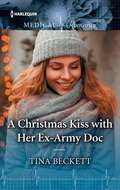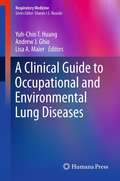- Table View
- List View
A Child to Heal Them: Healed By The Single Dad Doc / A Child To Heal Them (Mills And Boon Medical Ser.)
by Louisa HeatonMight saving a little girl……help mend their broken hearts?When ex-doctor Tasha Kincaid escaped to Africa to teach, haunted by the loss of a young patient, she never expected to find now-widowed Quinn Shapiro—the doctor who once broke her heart. But a pupil is sick, and she needs his help! As they care for little Abeje, Tasha finds herself falling for Quinn again—could healing this child help them embrace a future together?
A Child to Open Their Hearts
by Marion LennoxA child in need... When Nurse Hettie de Lacey saves orphaned Joni from drowning, she sets her heart on adopting him. This is her last chance to be a mom... But to keep him she needs Dr. Max Lockhart by her side. Max has returned to Wildfire Island with a heavy heart, and he's completely unprepared for the powerful desire he feels for Hettie. His life is already in turmoil, but how can he walk away when everything about Hettie and Joni compels him to stay?
A Child's Brain: The Impact of Advanced Research on Cognitive and Social Behavior
by Mary FrankOffers research on the development, organization, and operation of the child’s brain. This volume outlines for educators the essence of the burgeoning fields of brain research specifically focusing on the child's brain. Exploring the ageless questions of how do we learn, acquire knowledge, process information and what is memory, and additionally what are the organisational, curricular and instructional implications for educators. This issue discusses the breakthroughs of computer science in understanding brain functions, research into the hemispheric processes of the brain and the emerging area of cognitive science, in relation to educators and the translation of recent brain research into practice.
A Child's Eyes: A Guide to Pediatric Primary Care
by John W. Simon Joseph H. CalhounThis quick easy to read reference book is written for primary care physicians, parents and non medical professionals. It covers many common childhood eye disorders / injuries and includes vivid descriptions of numerous eye conditions.
A Child's Journey to Recovery: Assessment and Planning with Traumatized Children
by Terry Philpot Patrick Tomlinson Mary WalshThis book shows how carefully planned and assessed treatment can help traumatized children. It outlines how to set up a process for measuring a child's progress towards recovery. Uniquely, the book describes a practical outcomes-based approach that can be provided by an integrated multi-disciplinary team. Particular themes addressed include the conflict between the child's chronological and emotional ages, the need to work at the child's pace, the importance of the whole-team approach, and the challenges involved in measuring progress. The authors describe clearly defined outcomes for recovery, how children are assessed and how recovery plans are made, and show how progress can be closely monitored and responded to through the continuing process of assessment. An in-depth case study is used to show how this works in practice. This book forms part of an integrated approach and is an ideal accompaniment to existing titles in the SACCS `Delivering Recovery' series.
A Child's Right to a Healthy Environment (The Loyola University Symposium on the Human Rights of Children #1)
by James Garbarino Garry SigmanIt's a startling reality that more American children are victims--and perpetrators--of violence than those of any other developed country. Yet unlike the other nations, the United States has yet to ratify the United Nations Convention on the Rights of the Child. Compelling, readable, and interdisciplinary, A Child's Right to a Healthy Environment provides an abundance of skilled observation, important findings, and keen insights to place children's well-being in the vanguard of human rights concerns, both in the United States and globally. Within this volume, authors examine the impediments to the crucial goals of justice, safety, dignity, well-being, and meaning in children's lives, factors as varied as socioeconomic stressors, alienated, disengaged parents, and corrosive moral lessons from the media. The complex role of religious institutions in promoting and, in many cases, curtailing children's rights is analyzed, as are international efforts by advocates and policymakers to address major threats to children's development, including: War and natural disasters.Environmental toxins (e.g., malaria and lead poisoning).The child obesity epidemic.Gun violence.Child slavery and trafficking.Toxic elements in contemporary culture.A Child's Right to a Healthy Environment is a powerful call to action for researchers and professionals in developmental, clinical child, school, and educational psychology as well as psychiatry, pediatrics, social work, general and special education, sociology, and other fields tasked with improving children's lives.
A China Business Primer: Ethics, Culture, and Relationships
by Michael A. Santoro Robert ShanklinThe COVID-19 pandemic underscored longstanding fissures in China’s business relationships with the West. If the West is going to develop a relationship of mutual trust and improve business relations with China in the coming decades, it is imperative to understand how to engage with Chinese thinking on ethics in business—this book explains how. Government officials, businesspeople, and business-ethicists have trouble communicating about issues in ethics, policy, and business across the China-West divide. This book shows how to overcome the us-versus-them mindset plaguing China-West relations by presenting to Western audiences an easy-to-understand yet deeply informed primer on core ideas and perspectives in Chinese cultural and philosophical thought. The book considers original texts of Chinese philosophy and religion, and applies principles from those writings to three business-ethics topics of enduring interest to business executives, government officials, and academics, namely, the protection of intellectual property, assurance of product safety and quality in the pharmaceutical supply chain, and human rights. This book is a must-read for those who want to forge constructive relationships with their Chinese counterparts based on mutual trust and understanding. The book is specifically relevant to business executives, but it should also be of interest to policymakers, educators, and students who seek to communicate more effectively with their Chinese counterparts, in particular about difficult and contentious business, policy, and ethical issues.
A Chinese Physician: Wang Ji and the Stone Mountain Medical Case Histories (Needham Research Institute Series)
by Joanna GrantA Chinese Physician is the portrait of a 16th century medical writer and clinical practitioner. Drawing on socio-economic/biographic, textual, and gender analysis along side a variety of sources, from hagiographical biographies to medical case histories, the book tells three very different but complementary stories about what it was to practise medicine in 16th century China. Woven together, these stories combine to create a multi-dimensional portrayal that brings to life the very human experiences, frustrations and aspirations of a well respected and influential physician who struggled to win respect from fellow practitioners and loyalty from patients. The book creates a vibrant and colourful picture of contemporary medical practice and at the same time deepens our understanding of the interrelationship between gender culture and medicine.
A Chosen Calling: Jews in Science in the Twentieth Century (Medicine, Science, and Religion in Historical Context)
by Noah J. EfronQuestions traditional explanations for Jewish excellence in science in the United States, the Soviet Union, and Palestine in the twentieth century.Scholars have struggled for decades to explain why Jews have succeeded extravagantly in modern science. A variety of controversial theories—from such intellects as C. P. Snow, Norbert Wiener, and Nathaniel Weyl—have been promoted. Snow hypothesized an evolved genetic predisposition to scientific success. Wiener suggested that the breeding habits of Jews sustained hereditary qualities conducive for learning. Economist and eugenicist Weyl attributed Jewish intellectual eminence to "seventeen centuries of breeding for scholars."Rejecting the idea that Jews have done well in science because of uniquely Jewish traits, Jewish brains, and Jewish habits of mind, historian of science Noah J. Efron approaches the Jewish affinity for science through the geographic and cultural circumstances of Jews who were compelled to settle in new worlds in the early twentieth century.Seeking relief from religious persecution, millions of Jews resettled in the United States, Palestine, and the Soviet Union, with large concentrations of settlers in New York, Tel Aviv, and Moscow. Science played a large role in the lives and livelihoods of these immigrants: it was a universal force that transcended the arbitrary Old World orders that had long ensured the exclusion of all but a few Jews from the seats of power, wealth, and public esteem. Although the three destinations were far apart geographically, the links among the communities were enduring and spirited. This shared experience—of facing the future in new worlds, both physical and conceptual—provided a generation of Jews with opportunities unlike any their parents and grandparents had known.The tumultuous recent century of Jewish history, which saw both a methodical campaign to blot out Europe's Jews and the inexorable absorption of Western Jews into the societies in which they now live, is illuminated by the place of honor science held in Jewish imaginations. Science was central to their dreams of creating new worlds—welcoming worlds—for a persecuted people.This provocative work will appeal to historians of science as well as scholars of religion, Jewish studies, and Zionism.
A Christmas Kiss with Her Ex-Army Doc: A Christmas Kiss With Her Ex-army Doc / Second Chance With The Surgeon (Harlequin Lp Medical Ser.)
by Tina BeckettCan a Christmas kiss……lead to their happy-ever-after?Nurse Hollee Cantrell is stunned when ex-army doc Clancy deOliveira begins working at her hospital. Years ago, they shared a passionate kiss—but then Clancy left and Hollee married his best friend. Now widowed, it’s time for Hollee to admit that her marriage was a sham and she’s never stopped thinking about Clancy. And as their desire reignites, it seems Clancy hasn’t forgotten her either…“Ms. Beckett is a wonderful author whose books I normally find easy to get into…. Overall, Ms. Beckett has delivered a good read in this book where the chemistry between this couple was strong right from the beginning and only gets stronger as this story progresses….”—Harlequin Junkie on The Surgeon’s Surprise Baby“Every medical romance I’ve read by Ms. Beckett has entertained me from start to finish, as she writes complex characters with interesting back stories, compelling dialogue that has me enjoying the growing relationship between the two main characters, and challenging obstacles for the characters to overcome and this story was no different.”—Harlequin Junkie on One Night to Change Their Lives
A Christmas Miracle
by Amy AndrewsHer knight in shining leathers! Trinity Walker has learned the hard way to stand on her own two feet for her sick son, Oscar. But, when ex-army surgeon Reid Hamilton walks into her life and offers her a job and a home, she can't refuse! He might ruffle her feathers, but Trinity can't help falling for the knight in motorbike leathers. Reid never expected this little family to bring such sparkle into his cynical life but now he'll do whatever it takes to give Trinity the love she deserves this Christmas!
A City Not Forsaken (Cheney Duvall, M. D. #3)
by Gilbert Morris Lynn MorrisWill Cheney Be Content in the Glittering Lights of High Society? OR NOT Cheney Duvall's attempt to help the mountain folks in the primitive wilderness of the Ozark Mountains had proven to be an extremely difficult experience for both her and her nurse, Shiloh Iron. When they return to her home in New York; Cheney determines to go into a private practice with the handsome Devlin Buchanan, a highly successful physician who had previously asked her to marry him. His sponsorship offered her an excellent chance for success among the most wealthy and refined residents of New York. But dark rumors of plague had reached New York well in advance of the arrival of the ship that was bringing Devlin Buchanan back from London. A cholera outbreak in London had been reported in the early spring of 1866, and the deadly pestilence was now transported on the steamship Virginia. Despite holding the ship in quarantine, New Yorkers knew it was only a matter of time before the disease would spread. Polite Society with its elite circles, glittering stores, finest of clothing, elegant carriages, and lush carpet is a far different world than Cheney has known. And while it's gratifying to brush elbows with the Rockefellers and Vanderbilts, her past work has left its mark deep in her soul. Can Cheney be content in a world of high society and pomp, or will the call of the poor and the horrors of the epidemic draw her back?
A Clinical Approach to Geriatric Rehabilitation
by Carole Lewis Jennifer BottomleyThe field of geriatric rehabilitation is constantly changing due to the discovery of new evidence-based evaluation and treatment strategies, as well as the continual support or refutation of older theories and practices. Now in itsFourth Edition, A Clinical Approach to Geriatric Rehabilitation has been updated to be at the forefront of these changes and includes free video content from MedBridge and a discount on a MedBridge subscription to geriatric rehabilitation courses offered by the authors.Drs. Jennifer M. Bottomley and Carole B. Lewis have compiled the plethora of available scientific research on geriatric populations and combined it with their years of actual clinical practice. Together this makes this text a complete evidence-based guide to the clinical care of geriatric patients and clients.The first part of A Clinical Approach to Geriatric Rehabilitation, Fourth Edition tackles applied gerontological concepts, providing the general knowledge base necessary for treating geriatric patients. Topics in this section include patient evaluation, an exploration of nutritional needs, and age-related changes in physiology and function, as well as many other foundational areas.In the second section, topics become more focused on patient care concepts like neurologic considerations, cardiopulmonary and cardiovascular considerations, and establishing community-based screening programs.In the final section, chapters center on administration and management, including important subjects such as attitudes, ethics, and legal topics, as well as consultation and research.New and updated in the Fourth Edition: Pearls section for succinct highlights of the content within each chapter The latest evidence-based practice interventions with complete references for further reading Updated graphics, pictures, and diagrams to illustrate the content Content summaries and streamlined text for enhanced readability Updated case studies to exemplify clinical decision-making Designed to provide valuable, real-life clinical knowledge, A Clinical Approach to Geriatric Rehabilitation, Fourth Edition gives physical therapists an evidence-based guide to the clinical aspects of rehabilitative care in older adult patients and clients.
A Clinical Approach to Neuro-Ophthalmic Disorders
by Vivek LalNeuro-ophthalmology is a merged subspecialty of neurology and ophthalmology dealing with complex multisystem diseases presenting with visual manifestations. This book helps the reader in recognizing, approaching, and managing such a patient. It covers the afferent and efferent systems, pupillary disorders, and Radiology of neuro-ophthalmic conditions. It features individual symptomatology with salient points, their management and differential diagnosis. It has case scenarios, key points, and algorithms along with self-assessment MCQ questions. Its simplified, step wise approach will be a useful resource for neurologists, ophthalmologists, physicians, pediatricians, and optometrists. Key Features• Features a simplified and stepwise clinical approach to neuro-ophthalmic disorders.• Includes case studies and clinical pearls along with self-assessment sections.• Covers to the point and crisp analysis of common complaints faced in neuro-ophthalmology. All the royalties of this book are donated to the Poor Patients Cell of PGIMER, Chandigarh.
A Clinical Casebook of Sleep Disorders in Women
by Imran S. Khawaja Safia S. KhanSleep disorders are very common among women during their lifespan, presenting in isolation or in combination with other illnesses particularly psychiatric and neurologic disorders. Pregnancy-related sleep disorders pose an interesting dilemma as this is a transient phase; these are associated with potential long-term effects on maternal and fetal health. Menopause and pre-menopausal stages lead to a significant change in sleep architecture, sometimes associated with insomnia with or without sleep related breathing disorder. Sleep architecture in men and women varies due to significant hormonal differences between the genders. However, sleep complaints are disproportionately higher among women. This book presents 20 clinical cases to understand the differences in presentation of symptoms and treatment options for various sleep disorders that are more commonly noted among women. These cases cover a spectrum of sleep related breathing disorders, sleep related movement disorders, hypersomnias, parasomnias, issues of sleep fragmentation leading to insomnia in association with hormonal changes and some unique cases encountered in our clinical practices. This compilation of interesting clinical cases presents trainees and experienced physicians with a useful guide to assist in their clinical practices and will stimulate further research and studies.
A Clinical Guide for Cancer Prostate Patient
by Narmada GuptaThis book imparts a thorough understanding of the proper diagnosis, evaluation, and management of a patient with prostate cancer. The book provides guidelines for evaluation and investigation to reach a diagnosis with appropriate risk stratification of the disease, which is essential to evaluate the patient's survival and quality of life after the treatment. The book offers assistance, as per the patient and disease factors, appropriate treatment planning for an individual patient, and treatment outcomes for a better follow-up. This book aims to cover all aspects of prostate cancer with an additional supplement to the existing books in urology. This book targets postgraduates in urology, oncology, uro-oncology, practicing urologists, oncologists, and prostate cancer patients to know all aspects of the disease.
A Clinical Guide for Management of Overweight and Obese Children and Adults (Modern Nutrition Science)
by Caroline M. Apovian Carine M. LendersWhile unhealthy diet and sedentary behaviors are second only to smoking as the leading preventable cause of death in the U.S., less than 45 percent of adult and pediatric obese patients received any prior advice from a physician to lose weight. The low rate of identification and treatment of obesity by physicians can often be attributed to lack of
A Clinical Guide to Occupational and Environmental Lung Diseases (Respiratory Medicine)
by Andrew J. Ghio Yuh-Chin T. Huang Lisa A. MaierA Clinical Guide to Occupational and Environmental Lung Diseases delivers a concise compendium to the diagnosis and management of occupational and environmental lung diseases, incorporating evidence-based guidelines where available. Each chapter provides an updated review and a practical approach to different occupational and environmental lung diseases. With rapidly changing technology, new conditions and exposures will undoubtedly emerge. Clinicians need to remain vigilant about assessing the potential link between lung diseases and environmental exposures, and this book provides a practical guide to recognize, diagnose, and prevent occupational and environmental lung diseases. Written for practicing clinicians including internists, pulmonologists, and primary care providers, as well as industrial hygienists and environmental regulators, A Clinical Guide to Occupational and Environmental Lung Diseases is a timely and important new volume and an invaluable contribution to the literature.
A Clinical Guide to Pediatric HIV: Bridging the Gaps Between Research and Practice
by Tiffany ChennevilleThis book examines the impact of pediatric HIV on children, adolescents, and their families. Beginning with an overview of pediatric HIV epidemiology, it traces the medical, psychological, and social dimensions of HIV through the trajectory of childhood and youth. It examines the latest research on a wide range of topics, including treatment adherence, cultural, legal, and ethical issues, and HIV stigma and its reduction. Chapters offer expert recommendations for clinicians working with children with HIV as well as researchers studying pediatric HIV. In addition, the book also discusses daily concerns associated with pediatric HIV, such as disease management, coping, access to services, risk prevention, and health promotion. Topics featured in this book include: The impact of pediatric HIV on families. Psychosocial considerations for children and adolescents with HIV. HIV prevention and intervention in the school setting. HIV disclosure in pediatric populations. How to design effective evidence-based HIV risk-reduction programs for adolescents. A Clinical Guide to Pediatric HIV is a must-have resource for researchers, clinicians, and graduate students in child and school psychology, social work, and public health as well as pediatric medicine, nursing, epidemiology, anthropology, and other related disciplines.
A Clinical Guide to Urologic Emergencies
by Hunter Wessells Shigeo Horie Reynaldo G. GómezA Clinical Guide to Urologic Emergencies A Clinical Guide to Urologic EmergenciesAn ageing population and a predicted shortfall in the number of urologists means that, increasingly, the management of complex urological problems will fall to hospital emergency departments and the surgeries of primary care physicians. With many doctors and medical students now having less exposure to urology, there is a real and urgent need for accessible and practical guidance in managing urologic emergencies.A Clinical Guide to Urologic Emergencies offers practical guidance to the best practices in diagnosis, treatment and management of patients with urgent urological conditions. Designed to be an extremely useful tool to consult in the clinical setting, it will be a vital source of information and guidance for all clinicians, irrespective of their level of urologic knowledge.Edited by an outstanding international editor team, this book is particularly aimed at physicians, advanced practice providers, and urology and emergency medicine trainees managing patients in diverse healthcare settings across the globe.A Clinical Guide to Urologic Emergencies is accompanied by a website featuring video content at www.wiley.com/go/wessells/urologic
A Clinical Guide to the Treatment of the Human Stress Response (Springer Series On Stress And Coping Ser.)
by George S. Everly Jr. Jeffrey M. LatingThis new edition emphasizes the unique contribution of this longstanding text in the integration of mind/body relationships. The concept of stress, as defined and elaborated in Chapter 1, the primary efferent biological mechanisms of the human stress response, as described in Chapter 2, and the link from stress arousal to disease, as defined in Chapter 3, essentially remains the same. However, updates in microanatomy, biochemistry and tomography are added to these chapters. All other chapters will be updated as well, as there has been significant changes in the field over the past eight years.
A Clinical Guide to the Treatment of the Human Stress Response (Springer Series On Stress And Coping Ser.)
by Jeffrey M. Lating George S. Everly, Jr.This comprehensive update of the now classic text applies the most current findings across disciplines to the treatment of pathogenic human stress arousal. New and revised chapters bring together the art and science of intervention, based in up-to-date neuroscience, starting with an innovative model tracing the stress-to-disease continuum throughout the systems of the human body. The authors detail the spectrum of physiological and psychological treatments for the stress response, including cognitive therapy, neuromuscular relaxation, breathing exercises, nutritional interventions, and pharmacotherapy. They also assess the strengths and limitations of widely-used measures of the stress response and consider the value of personality factors, cultural considerations, and resilience in stress mediation.Included in the coverage:The anatomy and physiology of the human stress response.Advances in neuroscience: implications for stress.Crisis intervention and psychological first aid.Neurophysiological rationale for the use of the relaxation response.Physical exercise and the human stress response. The pharmacological management of stress reactions. Disaster Mental Health Planning.Cultural Awareness and Stress.The Fourth Edition of A Clinical Guide to the Treatment of Human Stress Response offers readers a dual perspective, exceedingly useful in examining the origins of the stress response, and in preventing and treating the response itself. This rich integrative volume will join its predecessors in popularity among practitioners and students across disciplines and specialties.
A Clinical Lens on Pediatric Engineering: Pioneering Science and Technology for Cutting-Edge Patient Care
by Jamie Leigh WellsA Clinical Lens on Pediatric Engineering: Pioneering Science and Technology for Cutting-Edge Patient Care explores the depth and breadth of the newly applied science of pediatric engineering and its dawning era. Placing into context the origins of pediatric medicine and engineering, this deep dive into and beyond medical digital-to-device innovation integrates scientific rigor with clinical perspective, incorporating case examples of diagnostic and therapeutic breakthroughs, cautionary tales, and lessons in translation. The book begins by explaining the unique considerations of the developing child and the importance of including nuanced end-user and human factors early and often in the process of seeking biomedical solutions. It provides an overview of this population's diverse and dynamic biopsychosocial characteristics compared to adults, contrasting organ systems, cognitive maturation, bioethics, growth, and drug metabolism. A distinguished team of contributors supplies a comprehensive blueprint for transforming an idea through to clinical implementation, featuring the ever-expanding influences and intricacies of discovery. The book covers a wide array of topics, including fetal intervention, transplantation, regenerative medicine, addiction, ophthalmology, surgery (e.g., minimally invasive, orthopedic), cancer, nanotechnology, radiology imaging modalities, gene therapy, artificial intelligence (AI), machine learning, liquid biopsy, immersive technologies (e.g., augmented and virtual reality), neurodiversity, rare disease, critical care, robotics, materials science and tissue engineering. The design challenges specific to children’s hospitals and healthcare facilities are discussed, highlighting the flexibility needed to achieve optimal patient outcomes, gather meaningful data, and drive innovative progress. This landmark work calls on key stakeholders to address the obstacles related to funding practices, clinical trials, and other impediments that hinder the timely and safe delivery of life-altering and life-saving results. It provides child health innovators with the essential tools to bridge these gaps and drive transformation in the rapidly evolving landscape of pediatric care.
A Clinical Trials Manual From The Duke Clinical Research Institute: Lessons from a Horse Named Jim
by Margaret Liu Kate Davis"The publication of the second edition of this manual comes at an important juncture in the history of clinical research. As advances in information technology make it possible to link individuals and groups in diverse locations in jointly seeking the answers to pressing global health problems, it is critically important to remain vigilant about moral and ethical safeguards for every patient enrolled in a trial. Those who study this manual will be well aware of how to ensure patient safety along with fiscal responsibility, trial efficiency, and research integrity." —Robert Harrington, Professor of Medicine, Director, Duke Clinical Research Institute, Durham, North Carolina, USA The Duke Clinical Research Institute (DCRI) is one of the world's leading academic clinical research organizations; its mission is to develop and share knowledge that improves the care of patients around the world through innovative clinical research. This concise handbook provides a practical "nuts and bolts" approach to the process of conducting clinical trials, identifying methods and techniques that can be replicated at other institutions and medical practices. Designed for investigators, research coordinators, CRO personnel, students, and others who have a desire to learn about clinical trials, this manual begins with an overview of the historical framework of clinical research, and leads the reader through a discussion of safety concerns and resulting regulations. Topics include Good Clinical Practice, informed consent, management of subject safety and data, as well as monitoring and reporting adverse events. Updated to reflect recent regulatory and clinical developments, the manual reviews the conduct of clinical trials research in an increasingly global context. This new edition has been further expanded to include: In-depth information on conducting clinical trials of medical devices and biologics The role and responsibilities of Institutional Review Boards, and Recent developments regarding subject privacy concerns and regulations. Ethical documents such as the Belmont Report and the Declaration of Helsinki are reviewed in relation to all aspects of clinical research, with a discussion of how researchers should apply the principles outlined in these important documents. This graphically appealing and eminently readable manual also provides sample forms and worksheets to facilitate data management and regulatory record retention; these can be modified and adapted for use at investigative sites.
A Clinician's Brief Guide to Dementia and the Law
by Michael Kennedy Nick Brindle Christian Walsh Ben AldersonDementia is a topic of enormous medical, legal and ethical importance with considerable human and economic cost. Its importance grows with the change in demographics of the aging population and that people with dementia receive care in a wide range of settings. The legal and ethical problems raised in treating patients with dementia are diverse and complex and are dealt with by many practitioners on a daily basis. This book is a 'how-to' guide to understanding how the law applies to people with dementia, from diagnosis through to end-of-life. It explores the practical problems that people experience, and practitioners face, giving an accurate account of statute, court cases and other inquiries, to give readers an up-to-date account of the law and how it applies in this area. An essential read for clinicians and practitioners that work with patients with dementia, including psychiatrists, primary care physicians, nurses, social workers and advocates.

